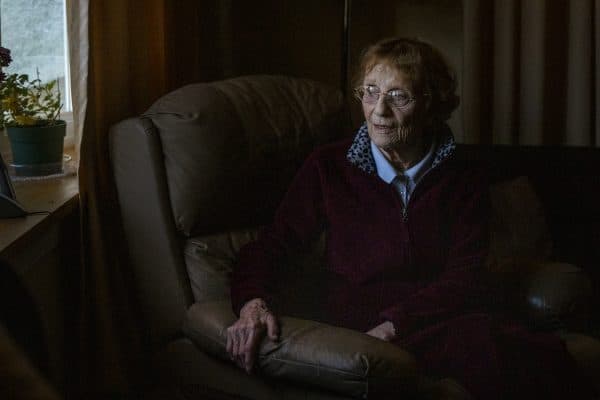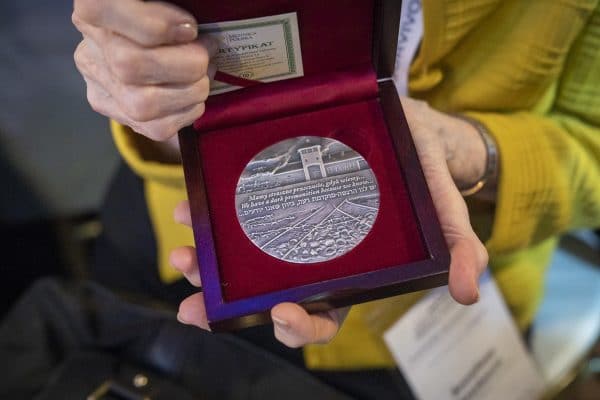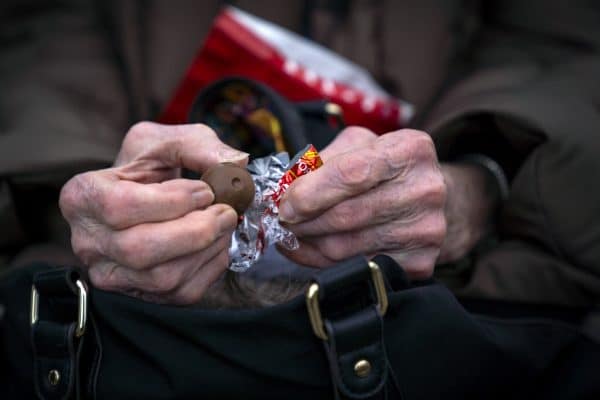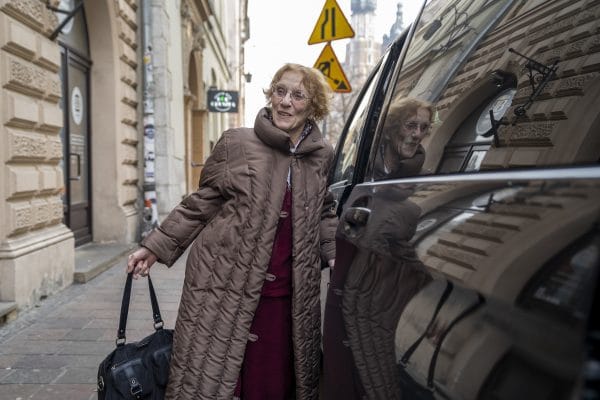In the breath between before and after, Anita Lewinski saw this was the end, and searched for her small goodbye. Their train had stopped at the gate of death.
It was October 1944. They were Jews.
The rail car had a window, by chance. Outside, the vast camps of Auschwitz-Birkenau sprawled across more than 400 acres of Poland’s southern countryside. Vacant eyes stared through barbed wire and barking dogs fought the leash. On the train, shock spread from face to face, reality replacing the long-whispered rumor.
Anneliese Winterberg was just 15. She had blue eyes, her hair blond as corn silk. Anita was a few days shy of 30, more a beloved big sister than an aunt. Anneliese watched her dig into a bag, looking resolute.
Seconds ticked by, then she found it.
Anita had been saving it for when this day came. She gave a piece to her older sister, Irmgard Winterberg, another to Anneliese, Irmgard’s daughter. She kept one for herself.

Holocaust survivor, Anneliese Nossbaum in her Jenkintown home before she goes on a trip with her family to Auschwitz-Birkenau for the 75th anniversary of the camps liberation. (Lauren Schneiderman/The Philadelphia Inquirer/TNS)
“We must eat it now!” Anita urged.
Before SS guards ordered them out, yelling “Raus! Raus!” and before Auschwitz-Birkenau, the dreaded taker took them in, a rare piece of chocolate held back the chaos.
“It was our last togetherness,” Anneliese recalled, “our last sweet sharing.”
ANNELIESE’S PLAN
On a rainy Tuesday night in the middle of January, Anneliese Nossbaum held the faces of two granddaughters in her small, soft hands and kissed them. She is 91 now, a mother of two and grandmother of four, living alone in a tidy row house in Jenkintown since the death of her husband, Martin, a decade ago.
Her grandchildren call her “Mom-Mom” and consider her a close friend, willing to pose for Snapchats and dish out advice. Hannah Nossbaum, 15, is the quieter of two sisters. She’s a freshman at AIM Academy in Conshohocken. Mayah is 18, a senior at Upper Dublin High School, her college choices “still up in the air.”
Mayah made Anneliese a birthday card recently, listing 91 reasons she loves her.

Holocaust survivor, Anneliese Nossbaum received a medal given to all Holocaust survivors in the room during a dinner for Holocaust survivors and their families put on by the Auschwitz-Birkenau Memorial Foundation, held in Krakow, Poland on January 26, 2020, the night before the 75th anniversary of the liberation of Auschwitz. (Lauren Schneiderman/The Philadelphia Inquirer/TNS)
No. 3: “You lighten up every room you walk into.” No. 12: “You are extremely intelligent.”
Anneliese usually sees them for Shabbat on Friday evenings. She spreads a white cloth over the dining room table and uses her mother’s candlesticks from Poland. They pray and drink grape juice, eating challah with salt.
“We acknowledge the goodness of life, especially the children,” she says, her German accent still thick.
On this evening, though, the girls came with their parents, Jeffrey and Jan Nossbaum, to talk about the family’s trip to Poland, to commemorate the 75th anniversary of the Soviet Red Army’s liberation of Auschwitz on Jan. 27, 1945. Edan Maoz, 28, Anneliese’s grandson, would meet them there. The Auschwitz-Birkenau Memorial Foundation was funding nearly all the expenses for the six of them and 100 other survivors. The Nossbaums allowed The Inquirer to join them and chronicle their journey.
The trip would be Anneliese’s second return to Auschwitz. She traveled there in 2016 for the March of the Living with her daughter, Ivette Maoz, and another granddaughter, Ma’ayan Maoz, walking the two miles from Auschwitz I to Birkenau, then flying to Jerusalem.

Holocaust survivor, Anneliese Nossbaum of Jenkintown, opens a piece of chocolate by the train tracks in Auschwitz-Birkenau, after sharing a story with her family about her aunt Anita Lewinski, sharing chocolate with her when they were on the train to Auschwitz in 1944. The Nossbaums traveled to Poland for the 75th anniversary of the liberation of Auschwitz. (Lauren Schneiderman/The Philadelphia Inquirer/TNS)
Over the decades, Anneliese has spoken to schools, religious and civic groups more than 100 times, and has recorded testimony for museums and filmmakers. She waves off retirement as if it were a buzzing fly.
“Absolutely, I’m booked,” she says. “Are you kidding?”
Her grandchildren learned about the Holocaust in middle school, and listened to Anneliese’s stories during Shabbat. Some of them heard her speak at their schools. But she kept the worst from them. She likens her talks to a staircase — one that leads to Poland, to Auschwitz, the final lesson.
“You can look at all the pictures you want, you can hear all the stories you want,” son Jeffrey said. “But when you actually are there firsthand and can identify with, this is what I’m talking about, this is where I was, this is what I went through — that speaks volumes.”
Anneliese had a vision for Poland, locations in Auschwitz she wanted the family to see, names to find among the endless scrolls of 6 million Jews murdered in the Holocaust. Of the 1.3 million people sent to Auschwitz, the deadliest of all Nazi camps, 1.1 million were killed — 960,000 of them Jews. One building she wanted to visit alone. She had a ritual in mind, too, to show Auschwitz that life found a way. Her family would pass through those gates, forever changed, witnesses until they die.
“And then that’s it,” she said. “I won’t go back.”
LIFE UNDER NAZI RULE
A few days later, just a week before leaving for Poland, Anneliese sat in her kitchen, the house empty and silent save for a ticking clock. There were bouquets of lilies on the dining room table, newspapers and books on the coffee table. Black-and-white photos lay on a sideboard. Among them was Aunt Anita in the 1930s, standing behind little Anneliese, their hair like night and day.

After taking a charter flight form Newark, New Jersey to Krakow, Poland, Holocaust survivor, 91-year-old Anneliese Nossbaum, arrives at the Hotel Stary in the Old City on January 26, 2020. The Nossbaums traveled to Poland for the 75th anniversary of the liberation of Auschwitz. (Lauren Schneiderman/The Philadelphia Inquirer/TNS)
“That’s a gas chamber,” Anneliese said, holding up another photo. “We’re going to go there at Birkenau, if I can walk that far. It’s all the way at the end.”
She painted a childhood of early happiness, then horror in high definition, her memory unaffected by age.
Anneliese was born on Jan. 8, 1929, in Guben, Germany, the only child of Siegfried and Irmgard Winterberg. When she was 2, the family moved west to Bonn, on the Rhine River, where her father took a position as a cantor and teacher. It was a blessing, she said, to be the cantor’s daughter. School and synagogue and friendships were her life.
“At school, my father was the teacher. At home, he was my father. He liked to drink beer. He used to let me sit on his lap, and give me a sip, too,” she said.
Adolf Hitler came into power in 1933, casting blame on the Jews for Germany’s woes. She remembers the Nazi parades, the bold red and black of the flag. She liked the Nazi music, but not the lyrics.
The changes happened slowly. She remembers “Juden verboten” appearing in store windows, but not feeling hurt until she learned the Nazis banned Jews from the swimming pool, too. “I never knew anything else but Nazis,” she said. “I was 4 years old.”

Holocaust survivor, Anneliese Nossbaum of Jenkintown, tells a story about her aunt Anita Lewinski, sharing chocolate with her when they were on the train to Auschwitz in 1944. At the same train tracks in Auschwitz-Birkenau, Nossbaum passes out chocolate to the members of her family to remember the moment on January 28, 2020. The Nossbaums traveled to Poland for the 75th anniversary of the liberation of Auschwitz. (Lauren Schneiderman/The Philadelphia Inquirer/TNS)
In summers, Anneliese split her time visiting grandmothers. Berlin was always her favorite destination. Anita was there. She was a teacher of handicapped children and, Anneliese said, had a natural way with kids.
“She spoiled me,” Anneliese said. “She took me all over the big city. I was about the happiest a kid could be around that time.”
In Germany, children carried notebooks and books of poems and adults would fill them up. Anita’s poem still resonates:
Dictionaries define menschen as “honorable people,” but Anneliese doesn’t think any translation fully captures the meaning. Anita, she says, was “menschen.”
Anneliese’s personal Holocaust began on Nov. 10, 1938, “Kristallnacht,” when Nazis and civilians burned and looted Jewish-owned stores in Germany. They destroyed her father’s synagogue. Nazi law replaced God’s law that day, she said. Jews tried to flee Europe. Her family had relatives in Los Angeles who offered to help them escape. The Winterbergs would take a train through Poland, to Vladivostok, Russia, to board a ship to the United States. Siegfried had a job waiting in Daytona Beach.
Then Germany invaded Poland, blocking their passage to America.
“We were trapped,” Anneliese said in a 1981 recording for the U.S. Holocaust Memorial Museum.

Holocaust survivor, Anneliese Nossbaum (center) and her family tour nazi death camp, Auschwitz-Birkenau, in Owicim, Poland on January 28, 2020, the day after the 75th anniversary of the liberation of Auschwitz. (Lauren Schneiderman/The Philadelphia Inquirer/TNS)
The Nazis moved her family to a cloister in Bonn. Her father still had religious services. His voice, she said, kept her feeling human. In July 1942, they were sent to Theresienstadt, a hybrid concentration camp and ghetto established by the SS in the former Czechoslovakia, in the fortress town of Terezín. They lived there for over two years, along with Anita and a grandmother. Treatment varied, she said, because the Nazis used the camp as propaganda, a “showcase” for the Red Cross. Yet, people often disappeared, given pink slips and a train ride. Her father got a pink slip on Yom Kippur in 1944. He was 44.
The night before he was taken away, Anneliese said goodbye. He laid his hands on her head and said, “May the Lord bless you and keep you.” Then she left the room. “I can’t recollect anything that happened after that,” she said. “Nothing.”
Siegfried went to Auschwitz, and died months later at Kaufering, a satellite camp at Dachau, Germany.
Anneliese’s train to Auschwitz arrived on Oct. 10, 1944. Outside, they shuffled toward a Nazi doctor sitting at a desk. Anita, born with a hip deformity, hobbled on a cane. Anneliese, tall for her age, was sent to the right with her mother. To live.
The doctor looked at Anita and quickly barked, “Links.”
Left, to death.
“For 30 years, I could not justify that this person who I loved so much was sent to the left,” Anneliese said. “We just looked at each other and she stood there with her mouth open, horrified, that she had to leave us. ‘I’m gone. Gone to death.’ That’s the look. That picture doesn’t go out of my mind.”
Most Jews were exterminated quickly. Those fit enough to work could live, for a while at least. Anneliese and Irmgard spent only five days at Auschwitz-Birkenau before being shipped to a labor camp, but in that time, life fractured for her. She was sent to a room where her body was shaved. She was given a dress and some old shoes. Childhood ended. Many girls cried seeing their hair fall to the floor. Anneliese didn’t.
Before she had gotten off the train, she had torn apart a photograph of her father, keeping just his head. She was so fearful the Nazis would find it during morning roll calls that she hid it in her mouth. After a few days, the photo dissolved. That’s when she cried.
“Like I lost him a second time,” she said.
The Holocaust would take all the people Anneliese first loved, her hair, her innocence, and one night in the barrack at Birkenau, her religion.
Irmgard had tuberculosis, and Anneliese would curl up beside her, drawing warmth from her night fevers. Still, she was cold. Others slept in burlap sacks, and Anneliese mustered up the courage to ask the kapo, a Jewish woman in charge of the barrack, if she could have one, too. The woman slapped her and made her kneel. She returned to her bunk, her face still stinging, and prayed.
“God, it’s me. I’m here in Auschwitz. Where are you?”
That night, she said, changed her completely.
Mother and daughter were sent to a labor camp near Dresden, where they built airplane parts for six months. They had one day off: Christmas. In April 1945, they were moved to Mauthausen, a concentration camp on the Danube River. The U.S. Army came in weeks later, then freedom. Irmgard, suffering from years without medical treatment, died shortly after. She was 41.
Anneliese came to the United States, alone, at 17, and lived with a distant aunt in Manhattan. She met Martin Nossbaum, a civilian equipment specialist for the military, and had children, living first in Mount Airy, then in Jenkintown. They kept a kosher house and had a religious life, at least on the surface. When cantors sang, she heard her father in their voices, felt his hands still resting on her head. She longed for the time when she believed, before that night in the barrack.
“I lived two lives,” she said, like a soldier home from war.
IN POLAND
The Nossbaums arrived in Krakow on Sunday afternoon, Jan. 26, after an eight-hour flight from Newark. Hours later, they sat with hundreds inside an old tram depot, at a survivors’ dinner hosted by the Auschwitz-Birkenau Memorial Foundation. Among the dignitaries was Ukraine president Volodymyr Zelenskiy, who called them “rays of light.”
Toward the end of the night, a video played on the stage of children singing “Hatikvah,” a poem that became Israel’s national anthem in the 1930s.
“Our hope is not yet lost,” they sang in Hebrew.
Tears pooled in Anneliese’s eyes. She had sung “Hatikvah” as a child. Mayah watched her mom-mom instead of the screen, tears in her eyes, too. Speakers mentioned the survivors’ ages. So many had left the world in recent years, and few could return for future anniversaries.
“I know there’s a chance a lot of them won’t be here in five years, but I don’t want to think about that, not yet,” Mayah said. “When she’s sad, I’m sad. When she’s happy, I’m happy. “
Anneliese received a medal during dinner, with the Auschwitz-Birkenau gate imprinted on it. She said she didn’t do anything special to survive, that others had it worse.
“She doesn’t feel like she deserves any of this,” Mayah said. “We constantly tell her how valuable she is, that without her, none of us would be here.”
Monday, Jan. 27, was the official anniversary of the liberation of Auschwitz, a long day for the family. A bus took them straight to Auschwitz-Birkenau. A massive tent covered the gate and the hundreds of people gathered there. The power of the place began to sink in.
“I was looking at the gate and wondering what it would have been like to pass through it,” Hannah said, “what my life would have been like after.”
Anneliese had been waiting for Tuesday, though, when the family would tour Auschwitz I and Auschwitz-Birkenau, together. It was their last day in Poland. The drive from Krakow to the camps took a little over an hour. The night’s wood smoke had sunk, mingling with the fog for most of the drive, a “fitting day to visit Auschwitz,” someone on the shuttle remarked. Anneliese looked through the windows, seeing Krakow’s endless church steeples, then frosted roofs in empty fields, then miles of forest, all blurred by the haze.
She kept her purse on her lap, her hands folded neatly on top. Rain pelted the windshield.
Jeffrey, wearing the kippah Anneliese had given him on his wedding day, fell asleep in the back. Mayah slept next to him, her legs perched on his knees. Hannah slept next to Jan, who was too nervous to sleep. She hadn’t lost anyone in the Holocaust, but felt the camps pressing on her as they approached. How would her daughters, particularly Hannah, her “innocent soul,” handle it?
“I hope it’s going to be healing,” Jan said.
Not long after they arrived, there was devastating news. Birkenau was closed because of ice, crushing most of Anneliese’s hopes for the day.
“That’s the whole reason she wanted to come on this trip,” Jeffrey said.
So they continued on in Auschwitz I for a guided tour, Edan pushing his grandmother in a wheelchair on the bumpy roads. She removed a red mitten to hold his hand. They passed through that camp’s infamous gate, with “Arbeit macht frei” written in arching metal over it.
“Work sets you free?” Anneliese muttered. “Yeah, right.”
Anneliese traded the wheelchair for a walker, up and down the stairs, to see glass cases filled with “evidence of crimes.”
“I know where we’re going,” she said to herself.
When the Russians liberated Auschwitz 75 years ago, they found 43,000 pairs of shoes. Most are on view there, many too small to fathom. There were pots and pans, suitcases and eyeglasses. One dimly lit case was full of human hair.
“You owned nothing,” she said. “They took it all.”
One display made Anneliese pause. She rested her head against the glass, looking for a cane among the back braces, prosthetic legs, and crutches. The family could see, through the reflection, that she was crying.
“That’s why Anita died,” she told Mayah. “She had so much to offer and the Nazis saw that cane and she was nothing to them, she was useless.”
Just before lunch, the sun wedged though the clouds. Every family member rushed over to Anneliese, to repeat the same sentence.
“Birkenau is open!”
The bus entered through the back, far from the gate of death. They recited the Mourner’s Kaddish by a gas chamber and joined a crowd singing “Hatikvah.” Edan braced his grandmother as she stepped over the mud and crouched down. She placed a stone on the brick wall above the pit. It was from Jerusalem. She traveled there after her 2016 return to Auschwitz, hoping to make amends for questioning her faith that cold night when the kapo made her kneel in the barrack. On her first morning in Jerusalem, Anneliese awoke before dawn and went to her balcony to talk to God.
The sun rose on the Western Wall.
“Please forgive me,” she prayed.
She wanted to visit that barrack to reaffirm her faith, but it was closed. And perhaps she didn’t need to.
The tour was ending. The cold began to creep back in, clouds closing in on the sun. The family came to a rail car, parked on the tracks where Anneliese and her mother were sent to the right and Anita to the left. She asked them to stop, and they circled around her.
Anneliese reached into her purse, and gave them each a piece of chocolate.
“This was our last sweet thing. And then she was gone, right here from this place, that sweet thing,” she told them. “Let us eat this and remember her, and everyone else who had these tender moments here, in this horror.”
One by one, they ate, then kissed Anneliese or put their hands on her shoulder. The family walked out of Auschwitz-Birkenau, the taste of chocolate lingering.
___
© 2020 The Philadelphia Inquirer
Distributed by Tribune Content Agency, LLC.



